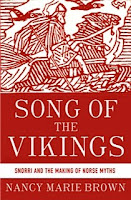Who influenced your favorite writers?
As Laura Miller reported in Salon recently, a group of mathematicians led by Daniel Rockmore of Dartmouth College analyzed the works of 537 authors who wrote in English from 1550 to the present. The mathematicans concluded that “today’s literary writers have little use for the classics,” in Miller’s wording. She continues, “They are, the study asserts, much more influenced by their peers than they are by the most revered authors of earlier centuries.”
The Dartmouth study focused on style--word usage--and I won’t disagree that no one these days writes quite like Shakespeare, Donne, or Milton. But look back farther than 1550 and you'll start to see more similarities.
Take Snorri Sturluson. A few years ago, when I began writing my biography of Snorri, Song of the Vikings (due out in October), I read Neil Gaiman’s best-selling genre-bender American Gods (published in 2001). I was delighted to see how heavily Gaiman was influenced by Snorri Sturluson, in both style and content.
American Gods won the Hugo and Nebula awards, was the first “One Book One Twitter” title in 2010, and is being made into an HBO television series. But put aside the fact that it’s a great story. What intrigued me is that American Gods essentially updates Snorri’s masterwork, the Edda, for both Gaiman and Snorri ask, What do we lose when the old gods are forgotten?
Gaiman’s Mr. Wednesday is closely patterned on Snorri’s Odin One-Eye, the god of Wednesday. In this passage from American Gods, Mr. Wednesday reveals himself—by paraphrasing Snorri: “His right eye glittered and flashed, his left eye was dull. He wore a cloak with a deep monklike cowl, and his face stared out from the shadows. ‘I told you I would tell you my names. This is what they call me. I am Glad-of-War, Grim, Raider, and Third. I am One-Eyed. I am called Highest, and True-Guesser. I am Grimnir, and I am the Hooded One. I am All-Father, and I am Gondir Wand-Bearer. I have as many names as there are winds, as many titles as there are ways to die.’”
Mourned Snorri in his Edda, “But these things have now to be told to young poets.” They have forgotten the names of Odin. The old lore is dwindling and will soon vanish into neverwhere: “But these stories are not to be consigned to oblivion,” he insisted.
And because of the books he wrote, they were not.
More than eight hundred years after his death, Snorri’s books are the basis of a best-selling American novel and a TV series. And Neil Gaiman is not the only author Snorri influenced.
Snorri Sturluson died, accused of treason by the king of Norway and murdered by thugs, in 1241. His books over time were forgotten, though manuscripts of them were preserved in Iceland and Norway.
Then in the early 1600s Snorri was resurrected. Translations from Old Norse began to appear throughout Europe. The craze led to the Gothic novel and ultimately to modern heroic fantasy.
Snorri has influenced writers as various as Thomas Gray, William Blake, Sir Walter Scott, the Brothers Grimm, Thomas Carlyle, Henry Wadsworth Longfellow, Alfred Lord Tennyson, Robert Browning, Richard Wagner, Matthew Arnold, Henrik Ibsen, William Morris, Thomas Hardy, Hugh MacDiarmid, J.R.R. Tolkien, Jorge Luis Borges, W.H. Auden, Gunther Grass, Gabriel Garcia Marquez, A.S. Byatt, Seamus Heaney, Jane Smiley, Michael Chabon, and Neil Gaiman.
Through Tolkien, Snorri has inspired dozens of writers of fantasy. Fantasy and science fiction now account for ten percent of books published, and few books on the fantasy shelves of modern libraries or bookstores are free of wandering wizards, fair elves and werewolves, valkyrie-like women, magic swords and talismans, talking dragons and dwarf smiths, heroes that understand the speech of birds, or trolls that turn into stone—all drawn from Snorri’s Edda and Heimskringla.
An incomplete list of fantasy writers indebted to Snorri includes: Douglas Adams, Lloyd Alexander, Poul Anderson, Terry Brooks, David Eddings, Lester del Rey, J.V. Jones, Robert Jordan, Guy Gavriel Kay, Stephen King, Ursula K. LeGuin, George R.R. Martin, Anne McCaffrey, and J.K. Rowling.
Snorri has inspired countless comic books—from Marvel’s Thor to the Japanese anime Matantei Loki Ragnarok—and games, including the wildly popular Dungeons and Dragons, World of Warcraft, and Eve Online. The hit movie The Avengers would not exist without Snorri.
Snorri Sturluson is the most influential writer of the Middle Ages. His Edda, according to one translator, is “the deep and ancient wellspring of Western culture.” That comment was published in 1909—how much more true it is today.
Join me again next Wednesday at nancymariebrown.blogspot.com for another adventure in Iceland or the medieval world.
Join me again next Wednesday at nancymariebrown.blogspot.com for another adventure in Iceland or the medieval world.




No comments:
Post a Comment